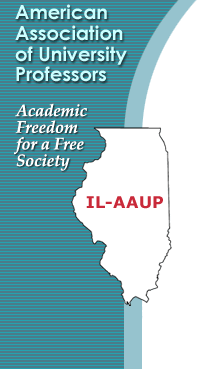 |
|
Financial Exigency: Policy Now, Hopefully Use Never
By Ken Andersen
Concern is manifest among faculty and administrators about the impact of the economic slowdown coupled with the probability of a slow recovery and a decline in public support of higher education expenditures. Institutional policies for dealing with financial shortfalls and possible financial exigency should be reviewed and as needed improved prior to the necessity to act upon them. What follows is an effort to urge faculty to be involved in such an effort and some ideas to consider. Faculty involvement may well avert an institution needing to move or moving to a declaration of financial exigency.
AAUP Financial Exigency Definition: An imminent financial crisis which threatens the survival of the institution as a whole and which cannot be alleviated by less drastic measures.
Note: The AAUP focus is termination of tenured faculty. But faculty must be involved long before such a determination is made when considering such things as salary and benefits reductions, layoffs, and/or program terminations. The rationale: these are to a significant degree educational policy decisions and hence faculty have a responsible role to play.
Causes:
1. Natural disaster: flood (New Orleans), earthquakes, tornadoes.
2. Sudden (external) economic disaster: Deep depression, fraud (a la Madoff).
3. Poor internal management:
a. Fraud or gross mismanagement by administrators and/or trustees.
b. Errors: fiscal, building commitments, failed projects, projected successes in enrollment.
c. Mission/implementation no longer viable in current times.
Exigency Policy:
1. Faculty body should participate in any decision re: an exigency with alternatives fully explored.
2. In an exigency AAUP Policy is:
a. A faculty member has a right to a hearing.
b. No new appointments unless distortion of academic programs results.
c. Effort to identify another position in institution.
d. Notice and severance pay.
e. Three years before faculty slot refilled unless offered to displaced faculty member.
Considerations in Setting a Policy:
1. Institutional culture and mission: Private institutions have much greater power to control their own destiny in many respects. Public institutions have responsibilities private ones do not, and are more reliant on government funding. Unionized faculty work in a different framework than non-unionized faculty.
2. Continuous active faculty participation in budgetary/salary matters: “The allocation of resources among competing demands is central in the formal responsibility of the governing board, in the administrative responsibility of the president, and in the educational function of the faculty.”(AAUP Redbook, p. 232) Relevant and accurate information should go to those who participate, including the faculty or its representatives (chosen by faculty) as appropriate to the expertise of each party. Changes in the planned budget in terms of actual expenditures needs to be monitored as well. While financial data is available for public institutions at a level beyond that of private institutions, IRS 990s, and the IPEDS data provide significant information if an administration is unwilling to provide it.
3. Establishing an appropriate set of other universities for comparative purposes is of value. The Illinois Board of Higher Education establishes such groups although there is dispute as to the appropriate groupings.
Avoiding Financial Exigency
1. Consistent faculty participation in institutional planning is essential. Many examples in Illinois and nationally could be cited of the negative results of failing to involve faculty and keeping them informed. Few instances result in a financial exigency but waste resources better utilized elsewhere and needless costs.
2. Develop faculty expertise through involvement in budget committees and planning issues with a focus both on continuity of representation coupled with gradual change of faculty participants to develop and spread expertise.
3. Utilize relevant institutional history and trends as part of the decision process. Examples: Do optimistic enrollment projections consistently miss the mark? Is the endowment being tapped for normal operating expenses? Does the institution engage in strategic planning drawing upon relevant stakeholders and updating the plan as needed? Is the institution realistic as to its financial status and prospects?
Some Cautions:
1. Do not conflate discontinuation or significant restructuring of a program or department with financial exigency. Restructuring decisions normally arise from quite different circumstances and reasons, require more faculty input, and have different potential time periods for implementation.
2. Any number of factors about the institution and its setting can contribute to solutions that have greater or lesser negative or positive impact on faculty, students, and staff.
3. Transparency during a process of assessment and decision-making is difficult but to the degree feasible it is reassuring to faculty, students, and staff.
|
|


